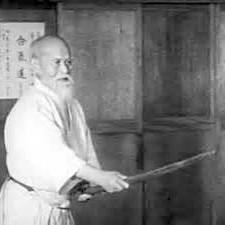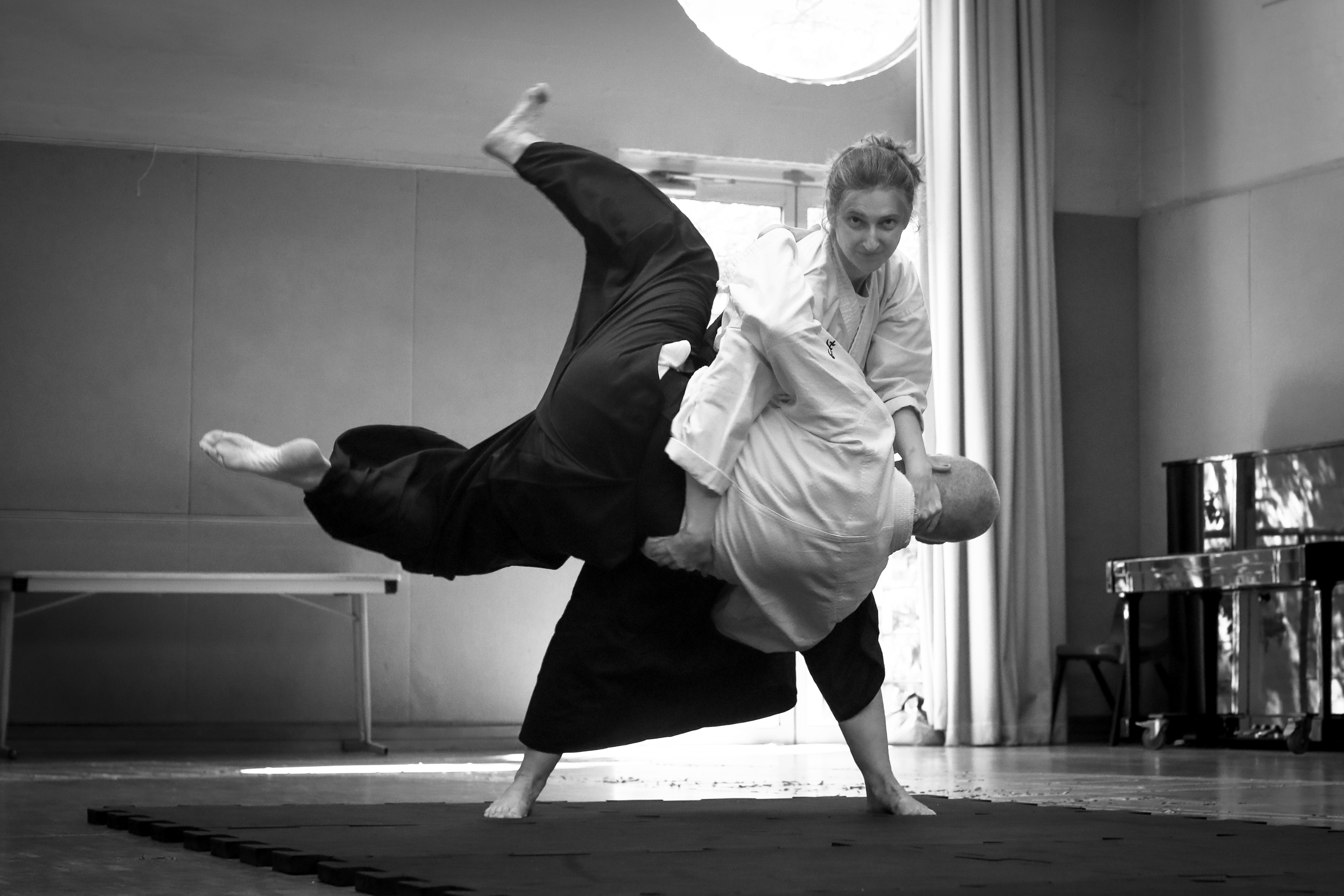 When the founder of aikido passed away in 1969, sword training at the Honbu dojo in Japan ceased to exist as a part of the regular curriculum.
When the founder of aikido passed away in 1969, sword training at the Honbu dojo in Japan ceased to exist as a part of the regular curriculum.
The importance and history of sword training in the study of aikido is discussed in this article by BiIl Gleason Sensei, chief instructor at Shobu Aikido of Boston. (~1300 words)
At that time sword training was only available for select high ranking students and was conducted somewhat behind closed doors. Although the taking away of an opponent‘s weapons continued to be a part of the testing process, teaching the use and handling of sword was, for all practical purposes, suspended completely.
Since that time the controversy over whether or not the practice of sword is really an integral part of, or even valuable to, aikido training has continued to intensify. There is little doubt however that the founder, Ueshiba Morihei O-sensei, considered it an essential part of his teaching as well as his own training. He constantly used weapons, especially the sword, to show the principles of aikido. Why is swordsmanship so valuable for understanding the essence of aikido? If we view this question from a historical perspective the answer becomes quite clear.
O-sensei, by his own declaration, although the founder of aikido, was not the creator of aiki principle itself. This principle was recognised in the ancient sword traditions of Japan as well as in the philosophy of Japanese Shinto. O-sensei was a devout student of Shinto and spent at least several years studying Japanese sword. Among the styles of sword that the founder studied was the ancient Kashima style which dates from the fifteenth century. The foundation of that school is the concept of shinbu ‘the divine martial way’ in which one wins without fighting. To accomplish this was to develop oneself, both physically and spiritually, to the level of the gods.
Shin in this case means ‘divine’ and bu refers to the creative force of life, the power of musubi, or becoming one with your partner. This was described as hōyō dōka, an all-embracing acceptance of even the negative feelings of others and the re-integration of that magnanimous attitude back to those who would attack us. Practically speaking this acceptance and re-absorption is the ability to receive your partner‘s energy and unify with it in such a way that their power is reduced to zero. In aikido this is a good explanation of what we call the power of kokyū. To master the spiritual and psychological aspects of this ability was called aiki. The word aiki was also used to denote the highest level of mastery in the Yagyū sword style in which O-sensei also excelled.
The really incredible achievement of the founder was to apply these principles to barehanded training in a new and unique manner. Why was this not accomplished in those ancient times? Every sword style contained its own interpretation of grappling or jutsu forms. This was necessary on the battlefield in case a warrior lost his weapon in the heat of battle. To be able to take away [another‘s] sword when you had no weapon was considered the highest achievement in the Yagyū style.
It required the great spiritual vision of O-sensei to see barehanded training not as grappling but rather as sword without a sword. Even the great Kano sensei, the founder of judo, declared aikido to be the art he had been searching for all his life. O-sensei through his own spiritual practices realised that we could use our hands, or even our mind alone, like a sword, to cut through our partner‘s attack or defence. Combining his spiritual vision with actual sword training he realised that it was possible to extend the influence of our ki, or intention, beyond our fingers in the same way that our movement and reach is extended when holding a sword. Ki extension is the essence of mutō or ‘sword without a sword’ and that is no better exemplified than in the practice of aikido.
In studying sword we learn to control the kensen, the line that the kissaki (the tip of the sword) draws in each cut. Eventually we are able to draw that line with our mind‘s eye alone. This ability is one of the secrets of aikido practice. It enables us to see the invisible form within each technique and to send out energy precisely to the correct place in our partner‘s body. This ability takes many years to realise; without sword training, the student is much less likely to discover it.
Cutting with the Japanese sword is an expansive motion in which the tip of the sword must be unified with one‘s centre. The basic diagonal cut, called kesa giri, may be equated with ikkyō in barehanded aikido training. If one truly masters this one cut, he or she has already realised shin shin toitsu or body-mind unification. Within kesa giri is the secret of natural spiral movement. The sword falls by its weight alone and the weight of the body comes to ride on top of its free fall. The turning of the hips and the subtle connection between your own centre and the tip of the sword create effortless power and speed. Just as in aikido, this basic way of cutting with the sword is dependent on a continual expansion of our feeling; in fact, that is the life of the movement itself.
In addition, the footwork and total overall movement of swordsmanship match that of aikido exactly. Every move in aikido, correctly understood, is a cutting motion. After all, the sword was created to fit the natural movement of the body and not the other way around. Herein lies one of the major differences between aikido and any of the various schools of jujutsu. The nikyō, sankyō, and yonkyō of aikido, for example, are performed as expansive cutting motions rather than as contracting wristlocks.
Aikido is an extremely subtle and difficult art. It requires a lifetime of dedication in order to grasp its essence. Because of its difficulty, aikido is quite often misinterpreted and practised either as a form of jujutsu or merely as aerobic exercise. Practising in either of these ways lacks both martial and spiritual content. Aikido techniques are designed to be ineffective until one has grasped the essence of expansive spiral motion and proper use of ki or internal power. They cannot therefore be effectively used in the same manner as jujutsu techniques, which depend largely on contracting motion for the purpose of breaking the partner‘s joints.
Combining the study of sword with barehanded techniques we are able to discover the complementary antagonism of flexibility and relaxed power together with sharpness and precision. In the words of the founder, “In barehanded practice you should move as if you had a sword; when holding a sword you should not depend on it but move as if you had none”. Studying this mental kamae, or stance, keeps us focused on the reality of a martial situation and at the same time allows us to remain flexible and relaxed. To unify these opposites is to discover aikido principle: yin and yang as one, movement and rest as one, irimi-tenkan as one, the unification of all opposites in a kind of dynamic monism.
This article is, of course, a large overview, and the many similarities between weapons and barehanded training can only come to be appreciated through proper training with a qualified teacher. It will not suffice merely to repeat sword kata as fixed forms without discovering their strategy and content. Each student, under the supervision of a qualified instructor, must take up the forms of both sword and barehanded training as parts of a whole, and through continual research and analysis, strive to refine his or her own individual practice to higher and higher levels of experts.
This article was first published in Shobu Aikido Aiki News (May 2001, Vol 2, No. 2). Thanks to Jeff Black who shared this on fb and Warwick Kent who brought it to our attention. This article has also appeared on aikiweb.
